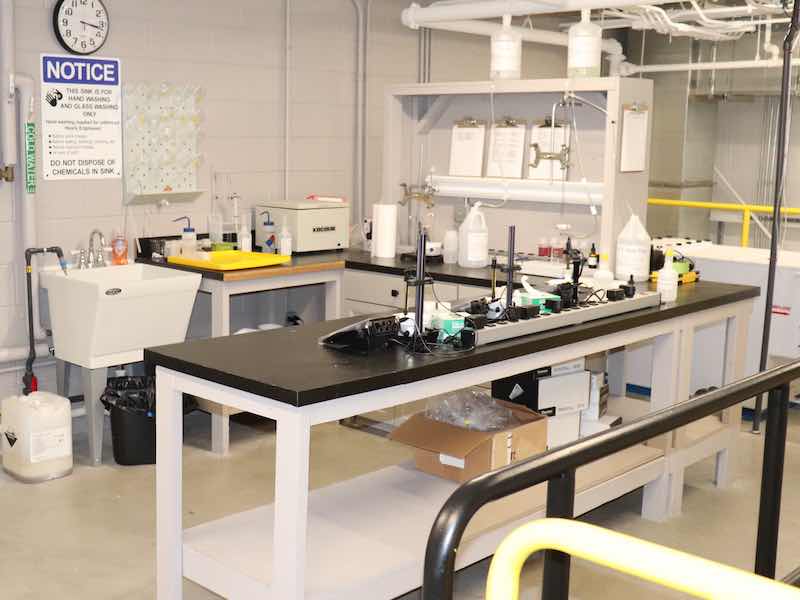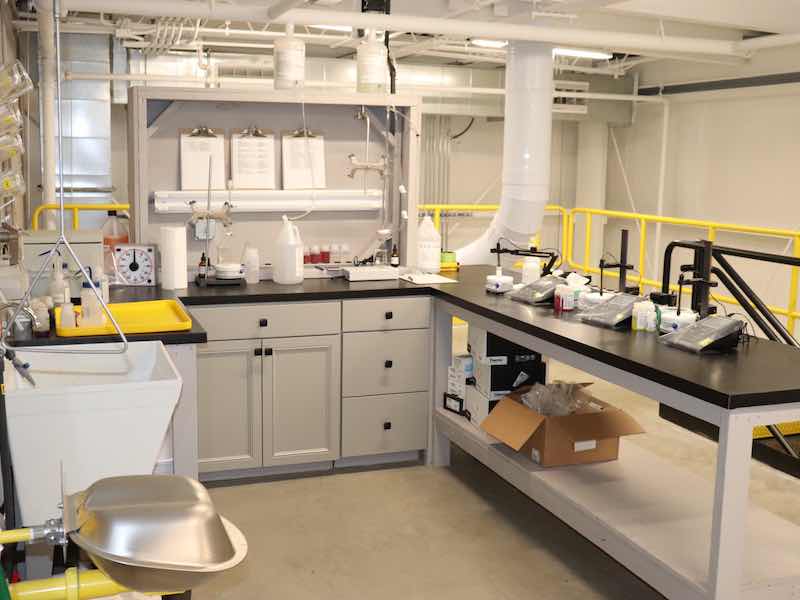The objective of this paper is to pass along the knowledge gained from some 60 years of providing chemicals, services, and technology to the hard chrome industry.
 Eric Svenson Sr.Our goal is to help the industry because hard chrome is a critical process that’s vital to our economy and our national security. Although this is directed towards hard chrome operations, it also applies to all electroplating processes, whether they’re performed in a job or captive shop.
Eric Svenson Sr.Our goal is to help the industry because hard chrome is a critical process that’s vital to our economy and our national security. Although this is directed towards hard chrome operations, it also applies to all electroplating processes, whether they’re performed in a job or captive shop.
Process control is becoming ever more important to the success of modern plating operations. This is critical in today’s industrial environment, where shops that provide the best quality and the greatest consistency receive the highest prices and the largest workloads. In short, they outpace their competitors by a wide margin.
Why It’s Important
A plating line is an assembly of process baths that includes cleaners, activators, plating solutions, and various rinse tanks. This includes large, automated plating lines and smaller manual systems. However, many hard chrome operations use fewer tanks because the cleaning is often done by hand, and the activation (reversing) is sometimes done directly in the plating bath, a common practice that’s not generally recommended.
"An unhealthy plating bath always produces poor-quality deposits, has higher reject rates, and increases production costs."
It’s critical to control these baths within their desired concentration range, regardless of the size and type of plating line. This control includes the chemical concentrations and the limit of impurities that should be tolerated. Of these, the plating bath is the most important because it’s the lifeblood of the operation.
That’s not to say the other baths aren’t important because they are. It’s just that the plating bath has the highest priority. An unhealthy plating bath always produces poor-quality deposits, has higher reject rates, and increases production costs.
Fortunately, the hexavalent chrome bath is fairly tolerable to reasonable levels of impurities; in fact, it’s one of the most forgiving of all the plating processes. But that doesn’t mean that it should be abused. Quite the opposite, the chrome bath operates best when its ingredients and impurities are controlled within fairly narrow limits. The worst mistake a plater can make is waiting until a problem develops before having a bath analysis done.
Critical Bath Ingredients
The hard chrome bath operates with only two primary ingredients, chromic acid, and sulfate. High-efficiency baths include 1-2 additional catalysts, but regardless, the chrome and sulfate levels are the most critical. These two components require frequent analysis and control. It’s very common for excess sulfate to unknowingly enter the bath through the water supply and impurities in the chromic acid used. The increased sulfate throws the chrome:sulfate ratio out of kilter, which results in any number of plating problems.
Sulfate is a true catalyst meaning it isn’t consumed during electrolysis. Its concentration only increases from drag-in or from bath additions. The sulfate level never decreases; naturally, it’s only lost through drag-out, a tank leak, or an overflow. This, along with its huge impact on the plating quality, is the reason it must be closely monitored and controlled.
On the other hand, the chromic acid level gradually decreases in relation to the number of ampere-hours plated. The consumption rate for chromic acid is typically around 100 lbs. per 400,000-ampere hours of plating if Zero Discharge Recovery is used for the rinsing and ventilation systems. It will be considerably higher if Zero Discharge is not being employed.
What is Typically Done
Many hard chrome shops don’t have in-house analysis capabilities, nor do they see the need for closer bath control. This is a huge mistake because maintaining the proper CrO3:SO4 ratio is incredibly important. Without this control, the deposit quality and, therefore, the profitability of the operation rapidly declines.
Old-school platers simply used a hydrometer to measure the Baumé (or density) of the bath as an indicator of the chromic acid level. This practice is wholly inadequate because the Baumé reading includes the impurities in the bath, like trivalent, iron, and copper. Therefore, the chromic acid level will always be lower than what’s indicated by Baumé. This upsets the critical balance of the presumed chrome:sulfate ratio.
Another mistake is many job, and captive hard chrome platers solely rely on their suppliers to provide their bath testing needs. This is problematic on several fronts:
- The time from when a bath sample is taken, received by the outside lab, and the results returned frequently spans several weeks, 2-3 weeks being typical in many cases.
- The bath has changed significantly with continued production during this time span. The results thusly obtained are meaningless as they don’t reflect current conditions. Therefore, the chemical additions made based on these reports are never correct, and the bath constantly stays out of balance.
- To make matters even worse, it’s also common for some shops to wait until a quality issue develops before they have a bath analysis done. This worst-case scenario causes huge problems with production, product quality, and profits.
Our laboratory specializes in hard chrome bath analysis and receives samples from all over the United States and overseas. Experience over the past thirty years indicates many bath samples were sent to solve quality issues that related directly to the imbalance of the chrome:sulfate ratio. This wouldn’t be the case if these shops had their own in-house analysis abilities.
What Should be Done
As a minimum, a chrome shop should have the ability to test its chromic acid and sulfate levels in-house. The frequency of bath analysis is based on maintaining the desired chemical balance within 2%-5% limits, with a 2% plus-minus variance being the most desirable. Most operations will find that doing this once a week meets that requirement.
The equipment needed for an in-house laboratory isn’t overly expensive relative to the benefits obtained. The space requirement isn’t prohibitive either, and typically 4-5 bath samples can be run in an hour’s time once the operator becomes familiar with the procedures.
Higher production operations may also want the ability to test their secondary catalyst, trivalent, and impurities like iron, copper, and chloride. However, these tests require additional equipment and operational expertise. Normally, using an outside laboratory to check these items is workable as their levels don’t change quickly, and the minor changes that do occur don’t affect the plating quality. That’s not to say their concentrations can be ignored; quite the contrary, it’s just that having them tested monthly is usually adequate.
Who Should Do This
The task of taking a bath sample, doing the analysis, and making the bath additions should be delegated to a single individual. Using multiple employees for this invites confusion and potential problems. The best employee for this is frequently the lead shift foreman or the plating supervisor.
Lab Requirements
 The old-school box-type test kits are inadequate for today’s process control requirements. Professional laboratory equipment is more durable and provides the best results. There’s an enormous difference in the accuracy obtained between using a test kit and using a dedicated laboratory with professional-grade reagents, glassware, and procedures.
The old-school box-type test kits are inadequate for today’s process control requirements. Professional laboratory equipment is more durable and provides the best results. There’s an enormous difference in the accuracy obtained between using a test kit and using a dedicated laboratory with professional-grade reagents, glassware, and procedures.
The in-house lab doesn’t need to be overly large or complicated, but using a small enclosed room is best. An area of 10’ x 10’ is adequate if it’s just used to test the chrome and sulfate. Ideally, this would be located near the plating line but away from any polishing or machining operations, so the lab stays free of airborne debris. Ideally, this room would be air-conditioned. This lab setup doesn’t need to be elaborate; all that’s generally required is the following:
- Several workbenches with kitchen-type cabinets underneath to store the glassware. Ideally, the bench tops would be covered with durable plastic; 1/4” PVC sheeting is ideal. Having a backstop and a top shelf along the back of the workbenches is a good idea.
- Several wall cabinets or shelves store the various reagents.
- Good fluorescent lighting, hot and cold water, and a small deep sink with a gooseneck faucet.
- Several duplex electrical outlets, or power strips, are distributed along the walls behind the workbenches.
- A desk and a file cabinet to store the lab records, a small computer, and a calculator.
Backup Testing
It’s also recommended that bath samples be sent to an outside laboratory on a regular basis for backup analysis. This is needed to test the other bath ingredients as the catalysts used and to check the accuracy of your in-house chrome and sulfate tests. This laboratory should also test the impurity levels of chloride, trivalent, iron, and copper. Using a laboratory that specializes in hard chrome technology is highly recommended for this.
The frequency of having the backup analysis done will vary with the amount of work plated and the tank volumes. Most shops find that doing this monthly is sufficient. The goal is to track the impurity level build-up before they cause plating issues. This prevents the huge peak and valley quality swings that some shops experience. The result is producing top-quality deposits repeatedly from month to month and year to year. It can also eliminate or greatly reduce the volume of rework required.
The chloride level is critical because it’s a very powerful contaminant. It should always be below 50 ppm, and keeping it below 20 ppm is highly recommended.
Besides creating plating problems, these impurities also decrease the plating efficiency, which increases the plating time and the AC electrical costs.
The trivalent Cr level is also important, and it should be maintained around 1% (as a percentage of the hexavalent chromic acid); it becomes an impurity when it’s much higher than 2%.
Iron and copper impurities become problematic when above 5 g/l individually or 5 g/l total when combined. Actually, copper has a much stronger negative effect than iron, so it should be kept as low as possible.
One reason these impurities cause problems is they chelate (tie up) the hexavalent chromium, thereby throwing the usable sulfate ratio out of kilter. They also increase the bath’s electrical resistance, which requires either raising the voltage or using reduced amperage. Besides creating plating problems, these impurities also decrease the plating efficiency, which increases the plating time and the AC electrical costs.
The best way to measure the combined effect of these metallic impurities is to determine the TCL level in the bath. TCL stands for Total Contaminant Level and is simply the sum of the trivalent percent plus the g/l of iron and copper added together. As an example, a bath having levels of 1.5% trivalent, 1.8 g/l of iron, and 1.2 g/l of copper would have a TCL of 4.5.
The only time a chrome bath is pure is when it’s first made up. Even then, it’s not truly pure, as there are trace impurities in the chromic acid and the water supply. Once made up fresh, the bath continually accumulates additional impurities as it used to plate parts. The rate of the impurity build-up is dependent upon several factors like the pre-plate finishing and cleaning, the reverse etching, the type of anodes and fixtures used, the location of the buss bars, and the stop-off techniques used.
Impurities Can Only be Controlled
The bottom line is these impurities can never be eliminated; they can only be controlled. This is done by reducing the TCL input as much as possible and then lowering it when they reach a predetermined level. Controlling the TCL is best done by first dummying the bath to reduce the trivalent and chloride and then decanting it (bath dilution) to lower the iron and copper levels.
It’s the author’s opinion that maintaining the TCL within the range of 4.8 – 7.2 provides the best option for maintaining high-quality deposits, lowering the rework rate, and increasing the overall efficiency and profits. This approach is significantly more efficient and less costly than using porous pots, ion exchange, or electrodialysis would be. Incidentally, porous pots do not remove iron or copper, and they are very inefficient for reducing the trivalent and chloride. Electrolytic dummying using a 20-30:1 anode ratio is the most efficient way to lower excessive trivalent and chloride levels.
As an example, a chrome bath sample was recently sent to our laboratory with the hopes of solving a major plating quality issue. It was a seven-year-old bath containing 5% trivalent and 23.2 g/l of iron and copper combined, giving it a TCL of 28.2. This is almost 4 times the recommended maximum TCL and equates to 348 pounds of tramp iron and copper dissolved in the 1,800-gallon solution. No wonder it couldn’t plate anything successfully. Unfortunately, that bath had to be dumped and remade fresh as there was no economical way to salvage it. The high cost of replacing that bath put a very significant dent in that company’s profits. Their high operational cost, poor quality, and loss of customer satisfaction could have been avoided had that shop just used better process control. A chrome bath that’s properly operated and controlled will last well in excess of fifty years and still be capable of high-quality plating parts.
But you can’t control your impurities, or other bath ingredients for that matter, without having a routine analysis done on the bath and its impurity levels.
However, many hard chrome platers don’t make a serious effort to control their bath impurities, instead allowing them to build to a level that creates serious plating issues. At that point, they either stop using that bath or dump and remake, a very costly affair. Meanwhile, their quality, efficiency, and profits continually decreased, and they may have even lost a customer or two along the way. All that could have been prevented by simply maintaining their TCL between 4.8 – 7.2.
But you can’t control your impurities, or other bath ingredients for that matter, without having a routine analysis done on the bath and its impurity levels. The TCL should be tracked over time so they can be dealt with when the TCL reaches 7.2. That’s why having the in-house capability to test the basic bath ingredients and then routinely using a qualified outside laboratory to check the catalysts and impurity levels is so important.
The cost for this service is offset many times over with improved plating quality, reduced rework, and much lower operational costs. Using an outside laboratory for backup testing and support shouldn’t be considered an expense; it’s an investment in quality control that’s repaid many times over with improved market positioning and increased profits.
The Pay-Off
Rework due to bath imbalances and excess impurities is a very costly affair because the part must now undergo stripping, refinishing, and replating. This cost is at least 3-times that of having plated it correctly the first time and likely even higher. This extra cost can’t be passed on to the customer and must therefore be absorbed.
Hard chrome platers that control their bath ingredients within a 2%-5% variance and control their impurity TCL within the 4.8–7.2 range have much lower operating costs, higher production efficiencies, and reduced rework rates. These factors relate directly to increased profitability and even to their long-term sustainability.
21st-century Industry demands high-quality and on-time deliveries. One of the best ways to meet their objectives is to take control of the plating bath and keep it healthy. Platers who follow this concept will prosper while those ignoring it, well – not so much.
All that’s needed for this operational improvement is exercising better process control. The cost of doing this is greatly offset and repaid many times over. It’s more than just a quality issue; it’s also logical and makes good business sense.
Eric Svenson Sr. is CEO of Plating Resources, Inc., in Cocoa, Florida. Visit www.plating.com or email Vicky@Plating.com



































